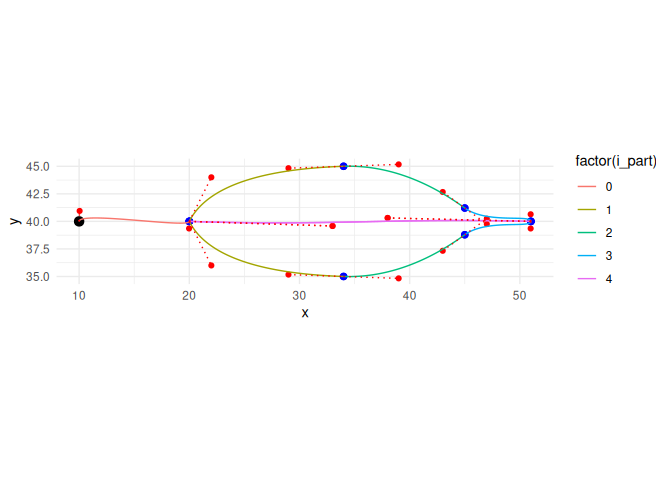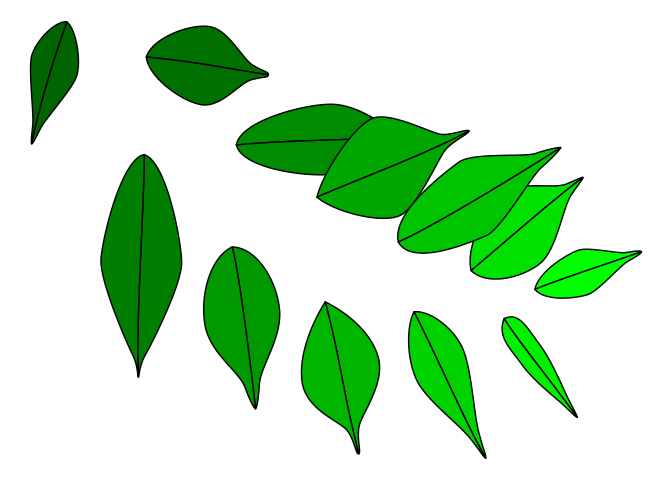The goal of this package is to generate shapes in the form of ficus benjamina leaves (weeping fig) with bezier curves. It is heavily inspired by the awesome flametree package.
You can install the newest version of ggbenjamini from github with:
# install.packages("remotes")
# (if not installed yet)
remotes::install_github("urswilke/ggbenjamini")First load some libraries:
library(ggbenjamini)
library(purrr)
library(dplyr)
library(tidyr)
library(stringr)
library(ggplot2)
library(ggforce)
set.seed(123)The package generates bezier curves that imitate the shape of the leaves
of a ficus benjamini. The main function is benjamini_leaf():
df <- benjamini_leaf()Show generated dataframe `df` of benjamini leaf bezier curve parameters
knitr::kable(df)| element | i_part | x | y | param_type |
|---|---|---|---|---|
| stalk | 0 | 10.00000 | 40.00000 | bezier start point |
| stalk | 0 | 10.04566 | 40.94991 | bezier control point 1 |
| stalk | 0 | 19.97942 | 39.35523 | bezier control point 2 |
| stalk | 0 | 20.00000 | 40.00000 | bezier end point |
| half 2 | 1 | 20.00000 | 40.00000 | bezier start point |
| half 2 | 1 | 22.00000 | 36.00000 | bezier control point 1 |
| half 2 | 1 | 29.00000 | 35.17208 | bezier control point 2 |
| half 2 | 1 | 34.00000 | 35.00000 | bezier end point |
| half 2 | 2 | 34.00000 | 35.00000 | bezier start point |
| half 2 | 2 | 39.00000 | 34.82792 | bezier control point 1 |
| half 2 | 2 | 43.00000 | 37.33259 | bezier control point 2 |
| half 2 | 2 | 45.00000 | 38.78709 | bezier end point |
| half 2 | 3 | 45.00000 | 38.78709 | bezier start point |
| half 2 | 3 | 47.00000 | 40.24159 | bezier control point 1 |
| half 2 | 3 | 50.97942 | 39.35523 | bezier control point 2 |
| half 2 | 3 | 51.00000 | 40.00000 | bezier end point |
| half 2 | 4 | 51.00000 | 40.00000 | bezier start point |
| half 2 | 4 | 38.00000 | 40.31141 | bezier control point 1 |
| half 2 | 4 | 33.00000 | 39.58294 | bezier control point 2 |
| half 2 | 4 | 20.00000 | 40.00000 | bezier end point |
| half 1 | 1 | 20.00000 | 40.00000 | bezier start point |
| half 1 | 1 | 22.00000 | 44.00000 | bezier control point 1 |
| half 1 | 1 | 29.00000 | 44.82792 | bezier control point 2 |
| half 1 | 1 | 34.00000 | 45.00000 | bezier end point |
| half 1 | 2 | 34.00000 | 45.00000 | bezier start point |
| half 1 | 2 | 39.00000 | 45.17208 | bezier control point 1 |
| half 1 | 2 | 43.00000 | 42.66741 | bezier control point 2 |
| half 1 | 2 | 45.00000 | 41.21291 | bezier end point |
| half 1 | 3 | 45.00000 | 41.21291 | bezier start point |
| half 1 | 3 | 47.00000 | 39.75841 | bezier control point 1 |
| half 1 | 3 | 50.97942 | 40.64477 | bezier control point 2 |
| half 1 | 3 | 51.00000 | 40.00000 | bezier end point |
| half 1 | 4 | 51.00000 | 40.00000 | bezier start point |
| half 1 | 4 | 38.00000 | 40.31141 | bezier control point 1 |
| half 1 | 4 | 33.00000 | 39.58294 | bezier control point 2 |
| half 1 | 4 | 20.00000 | 40.00000 | bezier end point |
It results in a dataframe of multiple bezier curves representing the
shape of a leaf. The first column element indicates which part of the
leaf the bezier describes, and can take the values “stalk”, “half 2” and
“half 1”. i_part denotes the id of the bezier curve, and x & y its
point coordinates. The column param_type denotes the type of the point
in the bezier curve.
The meaning is best illustrated with a plot:
Show code to generate plot
# rearrange data to display segments:
segments <- df %>%
select(-param_type) %>%
group_by(element, i_part) %>%
mutate(j = c(1, 2, 1, 2)) %>%
ungroup() %>%
pivot_wider(
names_from = j,
values_from = c(x, y),
values_fn = list
) %>%
unnest(c(x_1, x_2, y_1, y_2))
p <- ggplot(df, aes(x = x, y = y)) +
geom_point(color = "red") +
geom_point(
data = df %>%
group_by(element, i_part) %>%
slice(c(1, 4)),
color = "blue",
size = 2
) +
geom_point(
data = df %>% slice(1),
color = "black",
size = 3
) +
geom_bezier(
aes(
group = interaction(element, i_part),
color = factor(i_part)
)) +
geom_segment(
data = segments,
aes(
x = x_1,
xend = x_2,
y = y_1,
yend = y_2
),
linetype = "dotted",
color = "red"
) +
coord_equal() +
theme_minimal()The black point represents the leaf origin. Together with the blue
points they denote the start/end points of the bezier curves, and the
red dots the positions of their control points. The leaf is cut in two
halves (element == "half 1" OR "half 2") by the lines where
i_part == 4 (which represents the midvein of the leaf). The exact
dimensions of these coordinates are generated by random numbers in
certain ranges (see the definition of the argument leaf_params in
benjamini_leaf()).
In order to show the variations of the benjamini_leaf() (if parameters
are not explicitly specified), let’s only pass the position of the leaf
origins and let the function randomly generate the rest of the shapes:
dfb <- expand_grid(
x = seq(0, 200, 50),
y = seq(25, 125, 25)
) %>%
transpose() %>%
map_dfr(
~benjamini_leaf(gen_leaf_parameters(
x0 = .x$x,
y0 = .x$y
)),
.id = "i_leaf"
) %>%
unite(i, i_leaf, i_part, element, remove = FALSE)
ggplot(dfb) +
geom_bezier(aes(x = x, y = y, group = i)) +
coord_equal() +
theme_minimal()You can also generate branches of leaves with the command
benjamini_branch() (see the vignettes
vignette("create_benjamini_polygons") and
vignette("create_benjamini_tree") for examples):
df_branch <- benjamini_branch() %>%
# we add a unique identifier `b` for all beziers:
unite(b, i_leaf, element, i_part, remove = FALSE)
df_branch
#> # A tibble: 436 × 8
#> b i_leaf element i_part x y type param_type
#> <chr> <dbl> <chr> <dbl> <dbl> <dbl> <chr> <chr>
#> 1 0_branch_1 0 branch 1 70 280 branch bezier start …
#> 2 0_branch_1 0 branch 1 84 245 branch bezier contro…
#> 3 0_branch_1 0 branch 1 126 217 branch bezier contro…
#> 4 0_branch_1 0 branch 1 168 217 branch bezier end po…
#> 5 1_stalk_0 1 stalk 0 75.7 269. leaf_bezier bezier start …
#> 6 1_stalk_0 1 stalk 0 76.2 268. leaf_bezier bezier contro…
#> 7 1_stalk_0 1 stalk 0 73.8 264 leaf_bezier bezier contro…
#> 8 1_stalk_0 1 stalk 0 74.0 264. leaf_bezier bezier end po…
#> 9 1_half 2_1 1 half 2 1 74.0 264. leaf_bezier bezier start …
#> 10 1_half 2_1 1 half 2 1 71.4 264. leaf_bezier bezier contro…
#> # ℹ 426 more rowsAs the following plot also shows, benjamini_branch() adds another
column i_leaf specifying the index of the leaf on the branch.
df_branch %>%
ggplot() +
geom_bezier(aes(x = x, y = y, group = b, color = i_leaf)) +
coord_equal()If you want to fill the leaves with color, you can use
bezier_to_polygon() to approximate the bezier curves leaf parts with
polygons:
df_polygons <- df_branch %>%
filter(str_detect(element, "^half [12]$")) %>%
unite(idx, i_leaf, element, remove = FALSE) %>%
bezier_to_polygon(idx, i_leaf, element, i_part, n = 100)
ggplot(
data = df_polygons,
aes(x = x, y = y, group = idx, fill = i_leaf)
) +
geom_polygon(show.legend = FALSE, color = "black") +
scale_fill_gradientn(colours = c("darkgreen", "green")) +
theme_void() If you want to know more have a look in
vignette("create_benjamini_polygons") .
You can also transform the leaf data to svgs. Have a look in
vignette("create_benjamini_svg") for an example to generate svg
images.
This package stands on the shoulders of giants. It was only possible thanks to the following libraries:
- base (R Core Team 2021a)
- tidyverse (Wickham et al. 2019)
- ggforce (Pedersen 2021)
- grid (R Core Team 2021b)
- prismatic (Hvitfeldt 2021)
- flametree (Navarro 2021)
- rsvg (Ooms 2021b)
- minisvg (FC 2021)
- ambient (Pedersen and Peck 2020)
- covr (Hester 2020)
- stats (R Core Team 2021c)
- magick (Ooms 2021a)
FC, Mike. 2021. Minisvg: SVG Document Builder.
Hester, Jim. 2020. Covr: Test Coverage for Packages. https://CRAN.R-project.org/package=covr.
Hvitfeldt, Emil. 2021. Prismatic: Color Manipulation Tools. https://CRAN.R-project.org/package=prismatic.
Navarro, Danielle. 2021. Flametree: Generate Random Tree-Like Images. https://CRAN.R-project.org/package=flametree.
Ooms, Jeroen. 2021a. Magick: Advanced Graphics and Image-Processing in r. https://CRAN.R-project.org/package=magick.
———. 2021b. Rsvg: Render SVG Images into PDF, PNG, PostScript, or Bitmap Arrays. https://CRAN.R-project.org/package=rsvg.
Pedersen, Thomas Lin. 2021. Ggforce: Accelerating ’Ggplot2’. https://CRAN.R-project.org/package=ggforce.
Pedersen, Thomas Lin, and Jordan Peck. 2020. Ambient: A Generator of Multidimensional Noise. https://CRAN.R-project.org/package=ambient.
R Core Team. 2021a. R: A Language and Environment for Statistical Computing. Vienna, Austria: R Foundation for Statistical Computing. https://www.R-project.org/.
———. 2021b. R: A Language and Environment for Statistical Computing. Vienna, Austria: R Foundation for Statistical Computing. https://www.R-project.org/.
———. 2021c. R: A Language and Environment for Statistical Computing. Vienna, Austria: R Foundation for Statistical Computing. https://www.R-project.org/.
Wickham, Hadley, Mara Averick, Jennifer Bryan, Winston Chang, Lucy D’Agostino McGowan, Romain François, Garrett Grolemund, et al. 2019. “Welcome to the tidyverse.” Journal of Open Source Software 4 (43): 1686. https://doi.org/10.21105/joss.01686.





